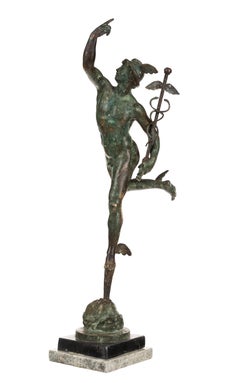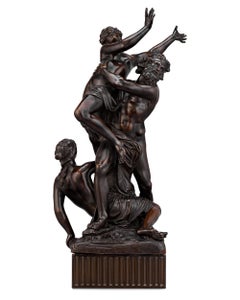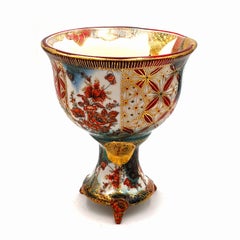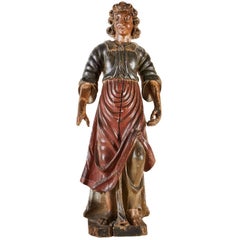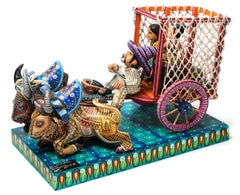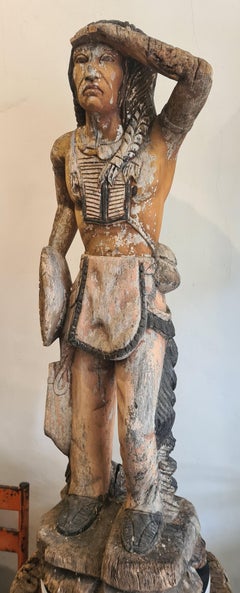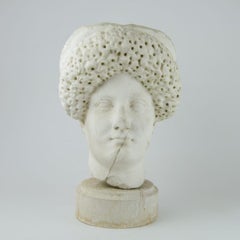Early 18th Century Figurative Sculptures
to
1
2
1
Overall Width
to
Overall Height
to
188
579
2,152
7,568
69
53
93
113
61
123
201
171
214
267
62
3
2
2
2
1
1
1
1
1
1
2
2
1
1
1
1
4
Period: Early 18th Century
After Giambologna Bronze of Mercury with green patina
By Giambologna
Located in New York, NY
Mercury, circa 1700s. Bronze with green patina. Height with base: 58 cm (22 7/8 in.)
Category
Baroque Early 18th Century Figurative Sculptures
Materials
Bronze
Bronze of Pluto Abducting Proserpine after François Girardon
Located in New Orleans, LA
After François Girardon
1628-1715 French
Pluto Abducting Proserpine
Bronze
This High Baroque period composition captures the famed narrative of Pluto and Proserpine from Roman mythology. The late 17th-century patinated bronze, created after François Girardon's marble composition, captures the very moment that Pluto seizes Proserpine. The anguished goddess reaches skyward, attempting to escape the god’s grasp while Pluto’s stoic face betrays his knowledge that his ploy will succeed. This pivotal moment in the mythological tale has captured the imagination of many art historical greats, from Bernini to Rubens. François Girardon’s version of the climax demonstrates incredible finesse and artistry, modeled expertly in bronze in the present work by a later sculptor. The statue brings a twist of intertwined bodies into a dynamic frenzy, paralleling the tension of the legendary story.
In ancient Roman mythology, Proserpine, the beautiful daughter of Ceres — known as Persephone in Greek mythology — was picking flowers in the fields when she was suddenly abducted by Pluto, the god of the underworld, and taken to his kingdom. Consumed with grief, her mother Ceres, the goddess of agriculture, scorches the earth, stopping the growth of grain and fruit. Jupiter attempts to intervene and secure Proserpine’s return to earth, negotiating a compromise with Pluto and the Fates that allows Proserpine to be released for part of the year before returning to Pluto’s underworld. Proserpine’s journey back and forth is an allegory for the changing seasons; when Prosperine is with her mother, the earth warms and provides bountiful harvests. Upon her annual return to the underworld, however, the earth once again becomes cold and barren.
After returning to France after years of training in Rome, François Girardon quickly rose to become one of the greatest artists in France. He was elected a member of the Académie Royale de Peinture et de Sculpture in 1657 and would become Chancellor of the Royal Academy in 1695. The artist was approached frequently for royal commissions and Girardon’s Pluto was originally commissioned by Louis XIV for the gardens at his Palace of Versailles. It was one of four monumental marble groups intended to decorate the corners of Charles Le Brun’s never completed garden at the chateau, the Parterre d’Eau. Each group of three figures symbolized one of the four elements: earth, air, fire and water. Pluto’s association with hell made him the apt...
Category
Baroque Early 18th Century Figurative Sculptures
Materials
Bronze
Just A Little Tipsy (MADE TO ORDER) (Sabbath, Kiddush, Unique, Gold Luster)
Located in Kansas City, MO
(MADE TO ORDER) (Sabbath, Kiddush, Unique, Gold Luster)
*Lead Time may vary between 1-3 weeks
Melanie Sherman
"Just A Little Tipsy"
Year: 2021
Porcelai...
Category
Rococo Early 18th Century Figurative Sculptures
Materials
Luster, Porcelain, Glaze
Large, 18th Century, Painted Santos Figure
Located in Los Angeles, CA
Hand-carved and painted, polychrome, Roman Santos figure in mid-stride. The figure wears stylized, flowing robes and stands atop a period base.
Category
Early 18th Century Figurative Sculptures
Materials
Paint, Wood
Related Items
Carreta Herencia de mi Tierra / Wood carving Alebrije Mexican Folk Art Sculpt
Located in Jesus del Monte, MX
FREE SHIPPING TO WORLDWIDE!
Artisan: Manuel Cruz Prudencio
MASTERPIECE
Made with Copal wood, woodcarving technique gouges, machete and sandpaper, decorated with acrylic paintings ...
Category
Folk Art Early 18th Century Figurative Sculptures
Materials
Wood, Acrylic
$2,063 Sale Price
24% Off
H 13 in W 19 in D 11 in
Cigar Store Indian, Early 20th Century, Carved Wood With Polychrome Decoration
Located in Cotignac, FR
A 20th Century wood carved male figure, a 'Cigar Store Indian' with original polychrome decoration.
A now controversial subject, but none the less charming rendition, of a native North American man originally probably used as an advertising figure. Wonderful quality of carving capturing the stance of the man looking out to the distance, hair flowing to his back and plait to the side, all the details of his costume, his native dress and hairpipe breastplate (suggesting he is possibly a Comanche) and chest ornament, apron, trousers, mocassins, shield and arrows. The original Polychrome decoration has weathered beautifully as has the wood itself to present a sculpture that would adorn any collection or interior.
Because of the general illiteracy of the populace, early store owners used descriptive emblems or figures to advertise their shops' wares. American Indians and tobacco had always been associated because American Indians introduced tobacco to Europeans. As early as the 17th century, European tobacconists used figures of American Indians to advertise their shops.
Because European carvers had never seen a Native American, these early cigar-store "Indians" looked more like Africans with feathered headdresses and other fanciful, exotic features. These carvings were called "Black Boys" or "Virginians" in the trade. Eventually, the European cigar-store figure...
Category
American Realist Early 18th Century Figurative Sculptures
Materials
Wood, Paint
$3,139 Sale Price
44% Off
H 37.01 in W 13.78 in D 11.82 in
Joel Urruty - Owl # 1, Sculpture 2024
By Joel Urruty
Located in Greenwich, CT
Medium: Basswood and milk paint (wall mounted)
As an artist, I strive to create elegant sculptures that capture the true essence of the subject matter. Form, line, and surface are u...
Category
Early 18th Century Figurative Sculptures
Materials
Wood, Paint
Pair of 18th century Renaissance style bronze sculptures - Lions
Located in Varmo, IT
Pair of small bronze sculptures - Grotesque lions. Italy, 18th-19th century.
10 x 5 x h 17 cm.
Made entirely of patinated bronze in Renaissance style. Depicting two seated grotesqu...
Category
Baroque Early 18th Century Figurative Sculptures
Materials
Bronze
$1,778
H 6.7 in W 3.94 in D 1.97 in
Pair of 19th Century Busts by Albert Ernest Carrier-Belleuse
Located in Santa Fe, NM
Signed: A. Carrier-Belluese
Two large bronze matching busts of an unknown male and female
22 x 10 x 11" male
23 x 10 x 9" female
Both show signs of wear with their age but are in fa...
Category
Baroque Early 18th Century Figurative Sculptures
Materials
Marble, Bronze
$6,000 Sale Price
50% Off
H 23 in W 22 in D 10 in
Rare and Important Italian Alabaster Bust Sculpture of Jesus Christ, C. 1860
Located in Queens, NY
A rare and important Italian alabaster bust sculpture of Jesus Christ, C. 1860
A modeled bust of Holy Christ wearing a crown of thorns, exceptional...
Category
Baroque Early 18th Century Figurative Sculptures
Materials
Alabaster
$110,000
H 21 in W 11 in D 4 in
Hercules
By Kim Seungwoo
Located in Palm Beach, FL
The Art of Currency: The Sculptural Mastery of Kim Seungwoo
In the vibrant art scene of South Korea, one artist stands out for his innovative approach to sculpture: Kim Seungwoo. With a profound appreciation for both traditional craftsmanship and contemporary themes, Kim has carved a unique niche for himself by transforming real Korean coins...
Category
Baroque Early 18th Century Figurative Sculptures
Materials
Copper, Steel
Visage de femme (Woman's Face), 1953
Located in Palo Alto, CA
Pablo Picasso ceramic Visage de femme (Woman's Face), 1953 is a vibrantly colored pitcher decorated with contrasting saturated greens against chestnut ...
Category
Modern Early 18th Century Figurative Sculptures
Materials
Ceramic, Clay, Earthenware, Glaze, Engraving
$24,500 Sale Price
30% Off
H 12.5 in W 7 in D 10.88 in
Vintage Peacock III (Wall Piece/Dish (hand-painted, made to order by the artist)
Located in Kansas City, MO
Melanie Sherman
Vintage Peacock III (Wall Piece/Dish (handpainted)
Porcelain, Glaze, Overglaze, Chinapaints, 24k German Gold Luster, Brass Wire (for hanging, can be removed)
Year: 2023 (and following years)
Size: 5.5x4x0.25in
Signed by hand
COA provided
Ref.: 924802-1333
*Made to Order Every piece is unique, design might differ slightly Customization possible
**Lead time approx. 2 weeks for qty 1-3
------------------------
My ceramics are handmade and painted with the finest overglazes from Europe. The gold luster used is 24k liquid Gold from Germany. Every piece is unique. My imagery is inspired by vintage Meissen dinnerware, William Morris wallpaper and other historical sources.
Porcelain, Ceramics, Pottery, Ornament
Vintage Moth Wall Piece Ornament Small Dish Candy Sugar Tea handpainted handmade butterfly peacock 24k German gold luster ceramics porcelain charm, jewelry, personalized, family, tree, retro, heart, mother, moon, baby, feet, gemstone, flower, mom, birth, year, art, chinapaint, luster, lustre, contemporary ceramics, futility of pleasure, herend, meissen, sevre, pattern, arita, arita ware, imari, imari ware, dresden, germany, japan, jingdezhen, china, photography, momento mori, flowers, flower motif, drawing, illustration, peacock, cherry blossom, chrysanthemum, kiku, 菊, kikka, 菊花, Ōka, 黄花, Kiku no hana...
Category
Baroque Early 18th Century Figurative Sculptures
Materials
Brass
$366
H 5.5 in W 4 in D 0.25 in
"MY WILLY", Miniature, camping trailer van, paper sculpture
By Drew Leshko
Located in Philadelphia, PA
This miniature paper sculpture titled "MY WILLY" is an original artwork by Drew Leshko made of paper, acrylic, inkjet prints, basswood, wire, PVC plastic, pastel, and clay. Through s...
Category
Contemporary Early 18th Century Figurative Sculptures
Materials
Wire
$2,200
H 16 in W 19 in D 2.75 in
Baroque Roman sculptor - 17th century bronze sculpture - Mars Warrior
Located in Varmo, IT
Gilded bronze sculpture - Mars, god of War. Rome, 17th century.
9 x 9 x h 31 cm.
Entirely in cast, chiseled and gilded bronze, resting on an ebonized wooden pedestal decorated with...
Category
Baroque Early 18th Century Figurative Sculptures
Materials
Bronze
$4,149 Sale Price
41% Off
H 12.21 in W 3.55 in D 3.55 in
"SEER" GESSO CARVED OIL ON WOOD PANEL HOUSTON ARTIST MID CENTURY MODERN
Located in San Antonio, TX
David Adickes
(1927 - present)
Houston Artist
Image Size: 10 x 8
Medium: Gesso, Carved, Oil on Wood Panel
"Seer"
Biography
David Adickes (1927 - present)
Adickes spent most of his professional life teaching, painting, and creating small bronzes. Now mainly known as a creator of giant sculpture, A commission for Houston's Performing Art Center in 1982 marks the beginning of his giant sculpture design. After the 36-foot tall cellist called the Virtuoso in a cubist style, he created a number of abstract works, including a giant cornet for the jazz stage at the 1984 World's Fair in New Orleans, Louisiana. Sculptor David Adickes is known for a major project titled Presidents Park in Williamsburg, Virginia, where he created 42 portraits bust of American presidents. Each sculpture is twenty feet tall, and their size was the subject of much protest and controversy. However, a court ruling allowed them to stay. President of Texas, followed by his 42 statue tribute to United States Presidents. Adickes has degrees in mathematics and physics which serve him well in the engineering of his works. Working on a giant sculpture series which includes the Beatles, and he hopes to end with a 280-foot tall cowboy statue...
Category
Impressionist Early 18th Century Figurative Sculptures
Materials
Wood, Gesso, Oil
$3,960
H 10 in W 8 in D 1 in
Previously Available Items
Marble head of Roman Empress Domitia Longina
Located in New York, NY
Marble head of Roman empress Domitia Longina, wife of emperor Domitian. The elaborate hairstyle, a distinctive feature of Domitia's depictions, is worked in great detail, and the ser...
Category
Early 18th Century Figurative Sculptures
Materials
Marble
Medaglione Profilo di Satiro in Marmo Scultura Italiana inizio XVIII secolo
Located in Pistoia, IT
Grande medaglione in marmo raffigurante il profilo di un Satiro, cerchia di Giovanni Bonazza, prima metà del 18 secolo.
Giovanni Bonazza fu il capostipite di una famiglia di sculto...
Category
Baroque Early 18th Century Figurative Sculptures
Materials
Marble
H 13.78 in W 10.24 in D 2.56 in
Early 18th-Century Terracotta Lion Statue
Located in New Orleans, LA
Terracotta Lion
Early 18th-century
A captivating blend of power and warmth, this majestic lion sits proudly upon its base, a noble guardian of the grand estate for which it was comm...
Category
Early 18th Century Figurative Sculptures
Materials
Terracotta
Diogenes of Sinope Large Bust in Marble 18th Century
Located in Pistoia, IT
Impressive white Candoglia marble bust depicting the Greek philosopher Diogenes of Sinope. Northern Italy, first half of the 18th century.
Diogenes of Sinope, called the Cynic, was ...
Category
Italian School Early 18th Century Figurative Sculptures
Materials
Marble
Monumental Italian 18'century Stone Sculpture of Mythological subject Apollo
Located in Rome, IT
Monumental and rare finely carved 18' century mythological subject sculpture of Apollo with flowers.
Very good condition from an estate of Veneto. We can deliver in a wooden cases
Category
Academic Early 18th Century Figurative Sculptures
Materials
Limestone
H 82.68 in Dm 31.5 in
Saint Mary Magdalene, a white marble medallion, after Etienne Le Hongre
Located in PARIS, FR
This marble medallion shows strong similarities to Etienne Le Hongre’s reception piece at the Royal Academy of Painting and Sculpture, which is now kept in the Notre-Dame Church in Versailles. While the suppleness of this sculpture evokes the Italian workshops frequented by Le Hongre before his arrival in Paris, the use of marble (and not terracotta, as was generally the case for the modelli) indicates that it is an independent artwork. It has not been possible, however, to determine whether this marble is an early work by Etienne Le Hongre, or a later interpretation of his reception piece, executed in a reduced format, by one of the Academy's students.
1. Etienne Le Hongre
Etienne Le Hongre was admitted to the Royal Academy of Painting and Sculpture in 1653, after his apprenticeship in the workshop of the sculptor Jacques Sarazin (1592 - 1660), and a three-year sojourn in Italy. He was finally admitted to the Academy in 1667 after the presentation of a marble high-relief featuring Saint Mary Magdalene...
Category
Baroque Early 18th Century Figurative Sculptures
Materials
Marble
H 16.34 in W 13.59 in
Buddha
Located in Nice, FR
Buddha sculpture in wood
Category
